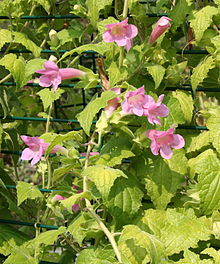Lophospermum

Lophospermum is a genus of herbaceous perennial climbers or scramblers, native to mountainous regions of Mexico and Guatemala. Those that climb use twining leaf stalks. Their flowers are tubular, in shades of red, violet and purple, the larger flowers being pollinated by hummingbirds. Now placed in the greatly expanded family Plantaginaceae, the genus was traditionally placed in the Scrophulariaceae. The close relationship with some other genera, particularly Maurandya and Rhodochiton, has led to confusion over the names of some species.
Lophospermum erubescens and Lophospermum scandens are cultivated as ornamental plants, as climbers or trailers. Various Lophospermum cultivars are grown, often under trade names such as “Lofos®”.
Lophospermum species are herbaceous perennial climbers with fibrous roots. They climb by means of twining leaf stalks (petioles) rather than tendrils or twining stems. The long stems are branched, becoming woody at the base with age. In some species the stems grow from a woody caudex – a swollen, bulb-like structure at the base of the stem. The leaves are triangular or heart-shaped with a pointed apex and toothed edges (crenate or dentate). Both stems and leaves may have a purplish colour.[1]
Species generally flower and fruit over a long season; for example, from April to the following January in the case of Lophospermum erubescens. The flowers are borne singly on stems (peduncles) which are either held horizontally or grow upwards. The calyx has sepals that are either free or somewhat joined at the base, and overlap or curve outwards. They may be green or tinted with red or purple. The flowers have five petals in shades of red, violet or dark purple, joined at the base to form a tube. The free lobes of the upper two petals are differentiated from those of the lower three petals: for example, the upper two may curve back and the lower three point forwards. There are two prominent folds (plicae) running along the length of the base of the flower tube, usually yellowish in colour with hairs whose length helps to distinguish the species. There are four fertile stamens, of two different lengths, and one infertile stamen. The stamens and style are held inside the flower.[1]
The ovary has two chambers (locules). After fertilization, an ovoid or globe-shaped capsule forms filled with brown seeds, each with a circular “wing” around it.[1
